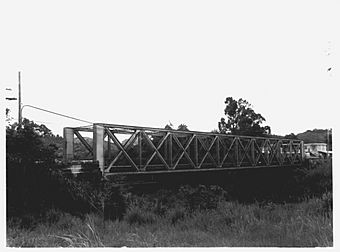Arenas Bridge facts for kids
Quick facts for kids |
|
|
Arenas Bridge
|
|

Arenas Bridge in 1993
|
|
| Location | |
|---|---|
| Area | less than one acre |
| Built | 1894 |
| Architect | Sichar, Mariano; Nicrisse & Decluve, et al. |
| Architectural style | metal truss |
| MPS | Historic Bridges of Puerto Rico MPS |
| NRHP reference No. | 95000843 |
| Added to NRHP | July 19, 1995 |
The Arenas Bridge is a special truss bridge built in 1894. It connects the towns of Cayey and Cidra in Puerto Rico. It's also known as Puente Rio La Plata.
This bridge was the longest one built in Puerto Rico when Spain ruled the island. It crosses the Rio de la Plata, which is the longest river in Puerto Rico! The U.S. National Park Service says it's "the most important metal bridge in Puerto Rico from the period." The good news is, the bridge is still standing today.
Contents
Building the Arenas Bridge
The Arenas Bridge was an important part of the Carretera Central. This was the very first main highway that crossed the central mountains of Puerto Rico.
The Carretera Central was a long road, about 134 kilometers (83 miles) long. It connected San Juan in the north to the port city of Ponce in the south. Most of this highway was finished by 1886. At that time, some river crossings had temporary bridges. Thirteen permanent bridges were also built. The Arenas Bridge was one of the last permanent bridges to be put in place. It was installed in 1894, just before the highway was fully completed in 1898.
Why Bridges Came from Far Away
Puerto Rico didn't have much iron back then. This meant there were no factories on the island that could make metal parts for bridges. So, bridges like the Arenas Bridge had to be made overseas.
A Spanish government agent in Paris would ask companies from different countries to bid on building these bridges. Many bids came from French and Belgian companies. The Arenas Bridge itself was made by a Belgian company called Nicaise et Delcuve. The bridge parts were then shipped all the way to Puerto Rico on a steamship named the Teutonia. Once the parts arrived, they were put together on site.
Choosing the Right Bridge Design
Engineers could have chosen a suspension bridge design for long crossings. This type of bridge was already well-known for spanning long distances. However, Puerto Rico didn't have extremely wide rivers or deep canyons that absolutely needed a suspension bridge.
The chief engineer at the time, Manuel Sanchez-Nunez, thought suspension bridges weren't good for Puerto Rico's tropical weather. He even had one taken down in Caguas that was built in 1857. Because of this, suspension bridges were not used much in Puerto Rico. Even today, there are only a few suspension bridges on the island. One is a modern walking bridge in Bayamon. Another is in Caguas. There's also a bridge for cars on the border of Bayamon and Naranjito, called the Jesús Izcoa Moure Bridge.
Who Designed and Built It
The Arenas Bridge was designed by Mariano Sichar. It's a steel truss bridge, which means it uses a strong framework of connected triangles. The bridge weighed about 23,623 pounds (around 10,715 kilograms). Building it cost 56,221 pesos.
Large stone supports called abutments were built to hold up the bridge. José Roque-Paniagua supervised the building of these supports. Engineer Julio Larrinaga was in charge of putting the bridge parts together.
Today, the bridge carries what is now Puerto Rico Highway 735. It crosses the Rio de la Plata between two areas called Barrio Monte Llano and Barrio Arenas. It is located right between the towns of Cayey and Cidra.
The Bridge During War
During the Spanish–American War, American soldiers moved from the south to the north using the Carretera Central. The Spanish army destroyed another bridge on the Carretera to slow down the American advance. However, the Arenas Bridge was not destroyed and remained standing.
See also
 In Spanish: Puente Arenas para niños
In Spanish: Puente Arenas para niños


